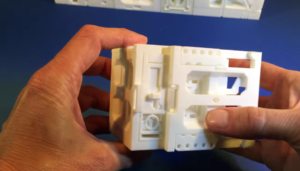The cube: it’s one of the more simplistic geometric shapes we know of, equal in width, length, and height on each of its sides. Yet despite its basic nature, this shape is also widely used to create Rubik’s Cubes and other complex, unique puzzles. From the bewildering design work of Oskar van Deventer, which has been named by many as ‘Rubik’s Cubes on steroids,’ to Sculpteo teaching customers how to design these cubic puzzles for 3D printing, it’s evident that 3D printing technology is increasingly being used to enhance and innovate upon this classic geometric shape.
Recently, an Iowa-based designer named Kurt Plagge began unveiling his own line of 3D printable cube designs, all of which were modeled to be printed in a single piece. Using the laser sintering technology offered by the Netherlands-based 3D printing service bureau i.materialse, Plagge has created a cube design with moving and interlocking parts within it. His 3D printed cubes are currently constructed from Polyamide material, a white, granular powder engineered for laser sintering. Thanks to his unique design and top-notch 3D printing technology, Plagge was able to create a intricate cube like no other.
His latest design, which is called the Articulated Cube 5, is able to open up and reveal a number of different shapes within, showcasing an endless amount of unique details despite being 3D printed as a single piece. Plagge, who graduated with a degree in architecture from Iowa State University, first ventured into designing intricate, moving parts for his architectural model building. Having used the 3D design software SketchUp on numerous occasions in the past, Plagge was instantly intrigued by the idea of designing something that was meant to be 3D printed. According to Plagge, he was fond of SketchUp because he was essentially able to do manual drafting in 3D format, which was a smooth transition over from his experience as an architecture student.
Since his cube designs are printed fully assembled and interlocked, one of the more difficult aspects of the design is maintaining the necessitated gaps between the moving parts within the cube, while also attempting to keep it as compact as possible. There’s also excess powder material that tends to get stuck around the moving parts, which Plagge spends hours removing after the 3D print is complete. The cube can certainly be considered as a constrained shape, which is exactly why Plagge is such an advocate of designing within it.
“I like the cube format for several reasons. They provide the maximum volume for the minimum printing price. I’ve made them modular (50mm, 75mm, 100mm) so they stack together neatly,” Plagge said in an interview with i.materialise. “And once I decide on a size, they provide a constraint so I can focus on the details and not concern myself with the infinite other shape options.”
According to the designer, he spends anywhere from 40 to 120 hours conjuring up his puzzling cubes, which he considers both his hobby and pastime. Plagge currently works in IT project management and security, which is how he makes his living. But it seems his true passion may lie within 3D designing, and 3D printing technology has helped him affirm that. In his recent interview with i.materialise, Plagge explains that the ability to hold his 3D printed designs in the palm of his hand has pushed him to aim for even more complex and intricately designed cubes. Looking into the puzzling depths of his Articulated Cube 5, I can’t even begin to fathom the inner workings of Plagge’s brain as he is 3D modeling these magnificent cubes. I’d imagine that it looks somewhat similar to the intricate insides of his moving, interlocking 3D printed cubes.
If you want to get your hands on one of these 3D printed cubes, Plagge’s Articulated Cube II design can be purchased from his i.materialise shop page, available in their Alumide material for $22.32 (excl. VAT). Plagge also participated in the i.materialise “Wood Challenge” last year, which called upon designers to create 3D printable objects for their wood material. Discuss over in the 3D Printed Cubes forum at 3DPB.com.
